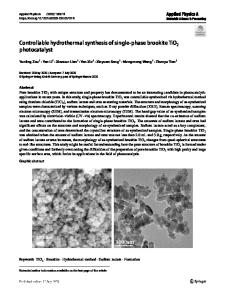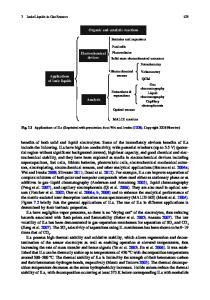Ionic liquids for the controllable preparation of functional TiO 2 nanostructures: a review
- PDF / 3,758,056 Bytes
- 25 Pages / 595.276 x 790.866 pts Page_size
- 78 Downloads / 278 Views
REVIEW
Ionic liquids for the controllable preparation of functional TiO2 nanostructures: a review Yuheng Zhang 1 & Wei Liu 1 & Siyi Chen 1 & Qing Gao 1 & Qi Li 1 & Xiashi Zhu 1,2 Received: 21 August 2019 / Revised: 4 July 2020 / Accepted: 27 July 2020 # Springer-Verlag GmbH Germany, part of Springer Nature 2020
Abstract Ionic liquids (ILs), as an innovative class of structure-directing agents, make them promising materials for composites in materials science. Particularly, the integration of ILs with TiO2-based photocatalysts opens up a new dimension in simplifying synthetic methods and improving TiO2 functions. This review summarizes recent progresses of IL-assisted strategies for the fabrication of functional TiO2-based photocatalysts with a special emphasis on the facilitation in the IL-assisted synthesis techniques including sol-gel reaction, hydrothermal/solvothermal process, and microwave method, as well as the enhancement in photocatalytic applications. Multiple roles that ILs played in the synthesis and photocatalysis (soft-template, crystallization promotion, microwave absorber, doping source, surface complex, etc.) have been classified and discussed in detail. In comparison with traditional methods, the advantages and shortages, as well as the future perspectives of ILs, are also proposed. It is believed that with the continuous exploration and development, new generation ILs will surely benefit materials science community. Keywords Ionic liquids . Controllable synthesis . TiO2 . Photocatalysis
Introduction Ionic liquids (ILs) are salts that are molten at, or close to, room temperature, which are composed of discrete anions and cations [1, 2]. Since 2000, the number of published papers concerning ILs has rapidly grown (Fig. 1). Indeed, the potential and benefits of ILs in various applications have been recognized and highlighted extensively [3, 4]. ILs possess the capacity for adjusting the properties through appropriate combination of the cations and anions [4]. Therefore, many different ILs have been reported in a vast array of uses including solid/liquid phase extraction, IL membrane for carbon capture, electrochemistry, polymeric-derived materials, and devices [5–7]. In addition, ILs are also good candidates for chemical synthesis. Over the past decade, it has been claimed that ILs are * Xiashi Zhu [email protected] 1
College of Chemistry and Chemical Engineering, Yangzhou University, Yangzhou 225002, China
2
College of Guangling, Yangzhou University, Yangzhou 225002, China
“green solvent” replacement for organic solvent due to their remarkable properties such as negligibly small vapor pressure, high thermal stability, good dissolution, and high ionic conductivity [8]. Therefore, varieties of metal nanoparticles and semiconductors were prepared through the IL-assisted methods because ILs can act as stabilizing agent, or structure-directing agent to protect the growing nanoparticles and mediate the formation of specific nanostructures according to different interactions like steric hindrance, ele
Data Loading...











